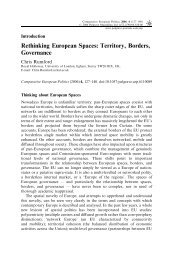Europeanisation, National Identities and Migration ... - europeanization
Europeanisation, National Identities and Migration ... - europeanization
Europeanisation, National Identities and Migration ... - europeanization
You also want an ePaper? Increase the reach of your titles
YUMPU automatically turns print PDFs into web optimized ePapers that Google loves.
196 Norbert Cyrus<br />
8 Another trend deeply influencing trade union policy in the construction sector<br />
was the economic performance of the construction industry. In the aftermath<br />
of the collapse of the GDR <strong>and</strong> the relocation of the German capital from<br />
Bonn to Berlin, the need for construction services increased in the 1990s to an<br />
unprecedented degree. Initially, the dem<strong>and</strong> for labour increased <strong>and</strong>, until<br />
1994, the use of migrant workers was complementary to resident employment.<br />
The number of workers employed by domestic firms increased from about<br />
100,000 to 1.08 million employees from 1991 to 1994. The replacement of<br />
domestic labour began only in 1995, when the numbers of workers liable to<br />
social insurance fell (between 1995 <strong>and</strong> 1998, there were about 245,000 fewer)<br />
but the amount of migrant workers nevertheless increased (Bosch et al. 2000:<br />
676). According to this account, since 1996, a substitution of resident construction<br />
workers can be observed. The number of employed resident workers<br />
liable to social insurance fell from 1.1 million in 1994, to 800,000 in 1998<br />
(Hochstadt et al. 1999: 201ff).<br />
9 The political volatility of this situation was exacerbated by the fact that the<br />
replacement of resident workers was unevenly distributed. Besides the disadvantaged<br />
areas of East Germany, the urban agglomerations with a number<br />
of construction sites which were difficult to control were also affected. The<br />
most dramatic locus of this development was Berlin. Here, the amount of<br />
construction activities increased between 1992 <strong>and</strong> 1995 by about 40 per cent,<br />
with a nearly constant level of employed resident construction workers liable<br />
to social insurance. Since 1996, construction activities <strong>and</strong> employment<br />
have decreased. At the end of the 1990s, the number of construction workers<br />
in Berlin was equal to the number of construction workers in the West Berlin<br />
of 1990. In view of the amount of construction activities in 1998, about 88,000<br />
construction workers are required. However, only 28,000 resident workers<br />
are employed: ‘The missing 60,000 employees either come from other regions<br />
of Germany (because of the advantages in the wage level, most likely from<br />
adjacent East Germany) or legal <strong>and</strong> illegal foreign workers from abroad or<br />
resident “moonlighters”‘ (Bosch et al. 2000: 676).<br />
10 The already relatively low rate of unionisation, estimated at 30–5 per cent, is<br />
still falling, which places the unions in a weaker position when presenting their<br />
arguments (Lubanski 1999: 284). The number of IG BAU members decreased<br />
from 653,000 in 1994 to 539,744 in 2000. 3 Taking into account that IG BAU<br />
had gained 80,000 new members by merging with a small trade union, the loss<br />
of members is even more dramatic (see Streeck <strong>and</strong> Visser 1998).<br />
As a result of these independent, but overlapping <strong>and</strong> mutually reinforcing<br />
developments, the labour market situation <strong>and</strong> the bargaining power of trade unions<br />
in the construction sector was eroded. According to an observer one can<br />
imagine that these are hard times for the German construction union IG BAU.<br />
Its strong bargaining power, which had successfully survived the crisis of the<br />
construction industry in the 1970s <strong>and</strong> in the 1980s, has now been upset. It is



